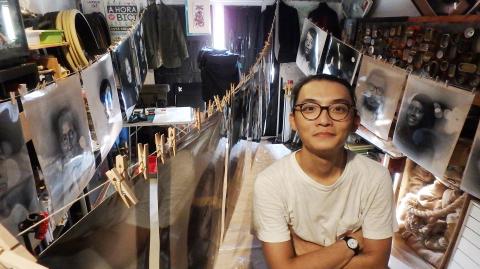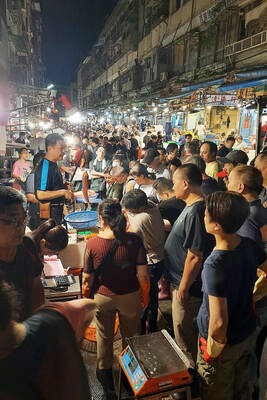In November last year, Malaysian artist Jeffrey Lim (林猷進) had just wrapped up a presentation on his photography project at Taipei’s Open Contemporary Art Center, an artist-run space, when he was asked why he embarked on it.
“I wanted to find out who am I,” said Lim, who was in town for a short visit on the invitation of Nusantara Archive, a Taiwan-based artists’ platform.
Lim’s deceptively simple answer led him to Taipei this month for a one-month art residency and his first solo exhibition, KANTA Portraits/work in progress (鏡頭下的容顏記 / 持續進行中), which begins on Saturday at Taipei’s Studio 94, an eclectic artist space run by non-profit Thermos Foundation. The exhibition will showcase a selection of works rooted in the theme: “exploring the ideas of identity, culture and nationhood through photography.”

Photo courtesy of Jeffrey Lim
Thermos serves as a platform to support alternative artists through workshops, events and exhibitions.
“I was moved by Jeff’s answer,” says Thermos director Sarina Yeh (葉姿吟) who was in the audience. “Many people fail to ask: Who am I? What do I really want in life?’ In the end, we follow the mainstream because we never question ourselves.”
PORTRAITS OF MALAYSIA

Photo courtesy of Jeffrey Lim
The main showpiece, Dinding Potret Kanta (2014-2017, translated as “Kanta Wall Portraits”), is a collection of portraits of Malaysians. Hand-printed on silver resin-coated paper, the portraits are framed in aluminum and steel food cans and bottle caps, and mounted on a 1.9m by 0.5m oxidized zinc panel.
Since 2014, Lim has been criss-crossing Malaysia, capturing portraits of everyday people in urban and remote villages using his handmade box cameras.
Dinding illustrates Lim’s use of typological photography — an approach that uses the camera as a tool to capture and classify subjects, to study identity through portraiture.

Photo courtesy of Jeffrey Lim
THROUGH THE LENS
Lim, 39, tells the Taipei Times that the project’s name Kanta (“lens” in Malay) holds a double meeting.
“Kanta is the medium that captures light to enable sight or image. The metaphorical meaning is how the different lens or filters affect how we view the world.”
Lim started the Kanta project in 2011 as an examination of self, identity, family history and its links to Malaysia. Lim, a second generation Malaysian Chinese, is labeled as a Chinese on his Malaysian ID, with Chinese and English names.
“But I have little or no affiliation to anything Chinese or China.”
In the project’s context, Lim attempts to question and deconstruct the nationally-constructed ideals of race, culture and religion that tries to define what and who its people are.
Dinding was exhibited at the recently-concluded Kuala Lumpur Art Biennale last year and acquired by Malaysia’s National Visual Arts Gallery for its permanent collection.
Lim’s use of photography as a medium stems from the measly but invaluable stash of old photographs of his ancestors that he found in his family archive.
His tool of choice — also called a mobile “photo studio” — was inspired by the Afghan Box Camera Project, a documentary by Austrian artist Lukas Birk and Irish ethnographer Sean Foley. Known as kamra-e-faoree, or “instant camera,” the homemade wooden device, which dates back to the 19th century, has been used in Afghanistan for generations. They are still used in remote parts of India, Europe, Brazil and Cuba, Lim said.
The pinhole camera uses no film but can capture and develop images.
“It’s basically light through a pinhole falling onto paper coated with silver,” Lim says. “My love for image-making and darkroom printing are found all rolled into one using a box camera.”
After receiving a seed funding grant from Kuala Lumpur-based Five Arts Centre in 2013, Lim fashioned several iterations of the box camera from recycled steel sheet tins used for storing cooking oil or biscuits, repurposed wood, glass offcuts and old bicycle tubes.
AUSTRONESIAN LINKS TO TAIWAN
The first time Yeh saw Lim’s portraits in November, she recalled getting goosebumps.
“I don’t know these people’s backgrounds, ethnicities or family history. But I see them as human beings,” Yeh says. “We don’t have to fit into a box. And perhaps Kanta project and this exhibition can inspire us to ‘unbox’ ourselves,” she says.
Thermos is sponsoring Lim’s research into Taiwan’s interiors.
During his Studio 94 residency, Lim will collaborate with Taiwanese artist Luc Chen (陳姿華), and journey to her Rukai ancestral village in Wutai Township (霧台), Pingtung County. Taipei-based Chen uses a homemade box camera as well, and wants to explore family ties, social structures and links to her own identity, through photography.
In his research, Lim learned about the many links between Taiwan and Malaysia.
Lim says there are two main language groups in Malaysia: The Austroasiatic, or West Malaysia, and Austronesian, West and East Malaysia. Many scholars have cited Taiwan as a starting point for the Austronesian language group.
“The Rukai community forms one of the original Austronesian language groups and has a close link to the Asia Pacific region,” he says.
After Pingtung, Lim plans to travel to Orchid Island (蘭嶼) to photograph and document the Tao (達悟族) people (known also as the Yami, 雅美族). Tao Aborigines originated from the Western Malayo-Polynesian (Austronesian) linguistic group. Their seafaring culture is synonymous with the seafaring cultures of Southeast Asia.
During his residency, Lim will document the social circumstances between rural and urban societies and to understand cultural identities — how people live, their spirituality and social environment, in contrast to how the country projects their identities. The artists will later present a series of photographic prints for display with stories and images also in audio or video formats.
THE JOURNEY CONTINUES
As Lim’s quest for identity continues, what has he uncovered so far?
“I realized this search for identity has evolved, from self definition, to the understanding that culture always reinvents itself and can never be defined or identified,” Lim says.
“Being conscious of the construct, the fragility and predicament of our times, and the reflection of human condition, perhaps it has become a pursuit to find a future beyond borders.”

The Taipei Times last week reported that the rising share of seniors in the population is reshaping the nation’s housing markets. According to data from the Ministry of the Interior, about 850,000 residences were occupied by elderly people in the first quarter, including 655,000 that housed only one resident. H&B Realty chief researcher Jessica Hsu (徐佳馨), quoted in the article, said that there is rising demand for elderly-friendly housing, including units with elevators, barrier-free layouts and proximity to healthcare services. Hsu and others cited in the article highlighted the changing family residential dynamics, as children no longer live with parents,

It is jarring how differently Taiwan’s politics is portrayed in the international press compared to the local Chinese-language press. Viewed from abroad, Taiwan is seen as a geopolitical hotspot, or “The Most Dangerous Place on Earth,” as the Economist once blazoned across their cover. Meanwhile, tasked with facing down those existential threats, Taiwan’s leaders are dying their hair pink. These include former president Tsai Ing-wen (蔡英文), Vice President Hsiao Bi-khim (蕭美琴) and Kaohsiung Mayor Chen Chi-mai (陳其邁), among others. They are demonstrating what big fans they are of South Korean K-pop sensations Blackpink ahead of their concerts this weekend in Kaohsiung.

Taiwan is one of the world’s greatest per-capita consumers of seafood. Whereas the average human is thought to eat around 20kg of seafood per year, each Taiwanese gets through 27kg to 35kg of ocean delicacies annually, depending on which source you find most credible. Given the ubiquity of dishes like oyster omelet (蚵仔煎) and milkfish soup (虱目魚湯), the higher estimate may well be correct. By global standards, let alone local consumption patterns, I’m not much of a seafood fan. It’s not just a matter of taste, although that’s part of it. What I’ve read about the environmental impact of the

Oct 20 to Oct 26 After a day of fighting, the Japanese Army’s Second Division was resting when a curious delegation of two Scotsmen and 19 Taiwanese approached their camp. It was Oct. 20, 1895, and the troops had reached Taiye Village (太爺庄) in today’s Hunei District (湖內), Kaohsiung, just 10km away from their final target of Tainan. Led by Presbyterian missionaries Thomas Barclay and Duncan Ferguson, the group informed the Japanese that resistance leader Liu Yung-fu (劉永福) had fled to China the previous night, leaving his Black Flag Army fighters behind and the city in chaos. On behalf of the